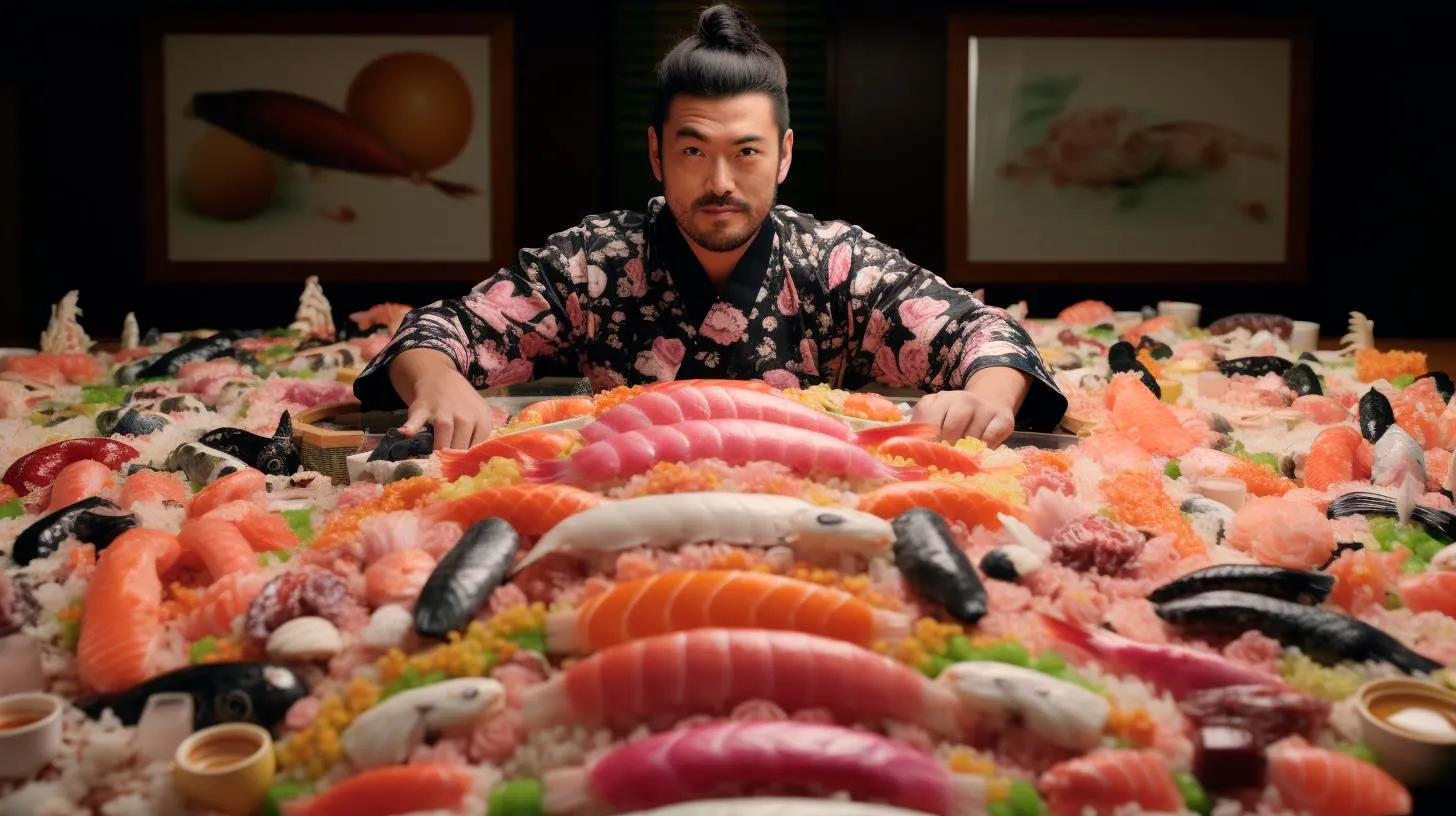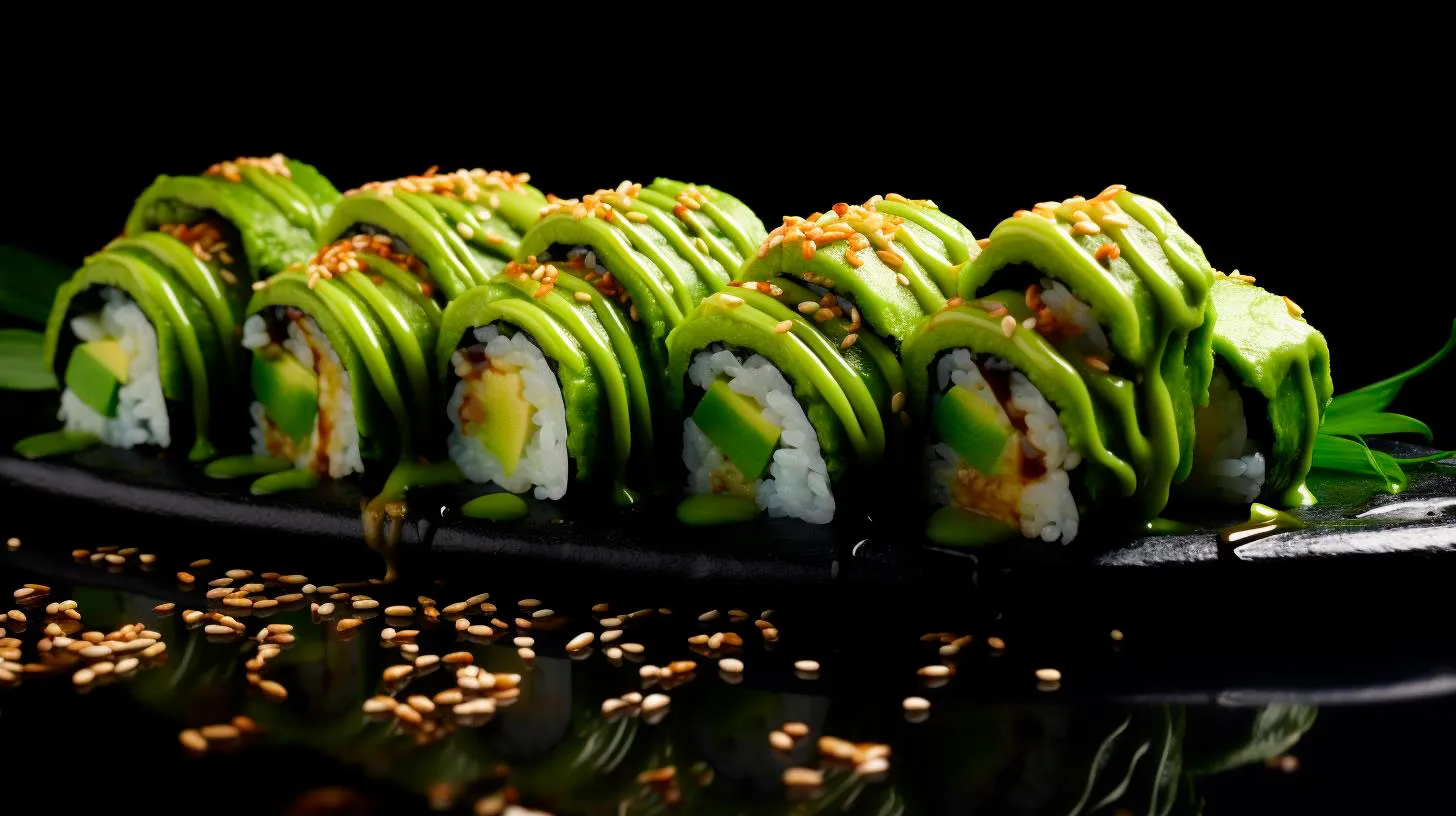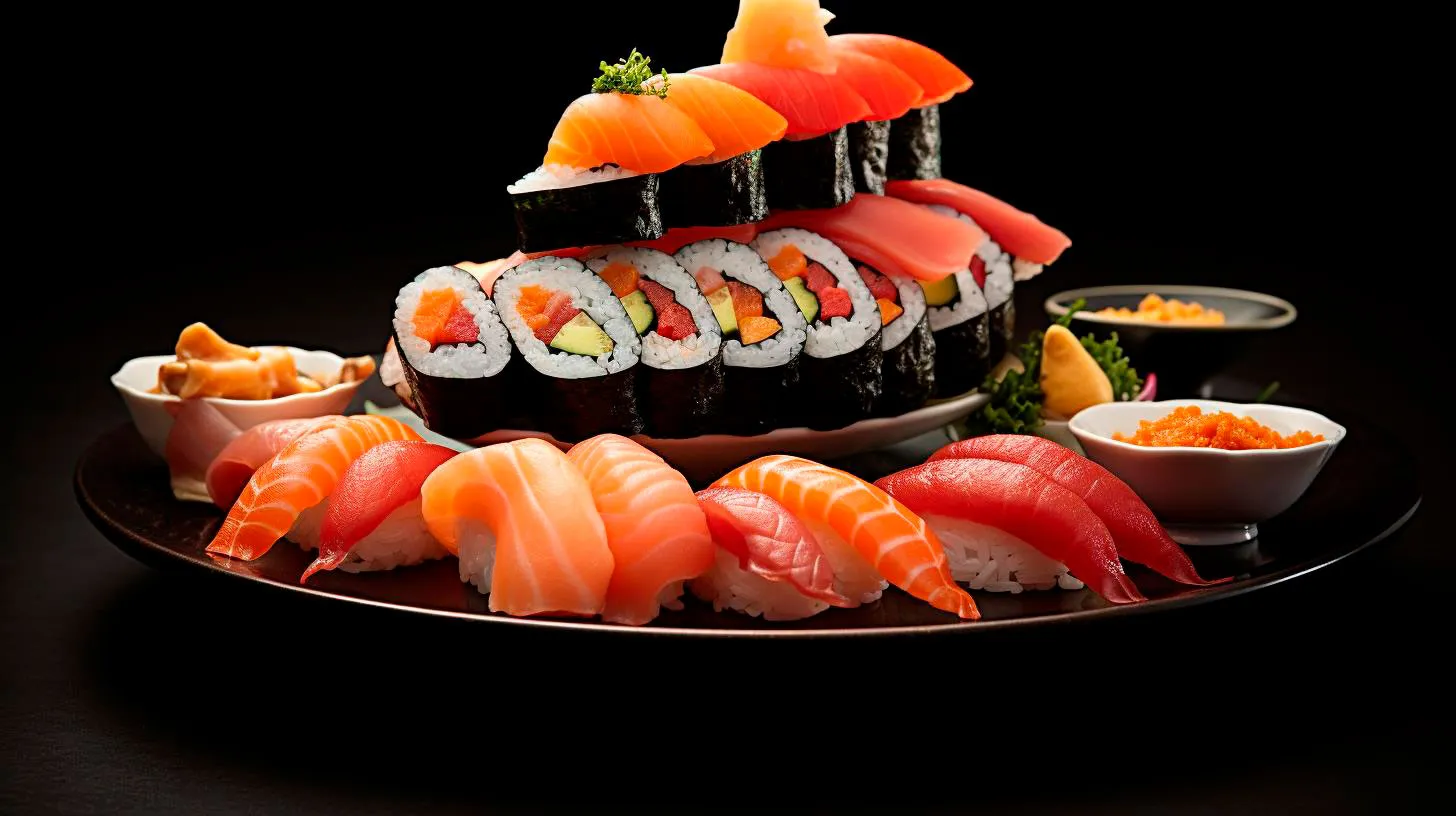Tobiko and Masago: Tiny Gems of Sushi
These small, flavorful beads not only add a burst of taste but also provide numerous health benefits. In this article, we’ll dive deeper into the world of tobiko and masago, exploring their origins, unique characteristics, health advantages, and ways to incorporate them into your sushi dishes.
1. Tobiko: The Colorful Fish Roe
First on our list is tobiko, a type of fish roe typically obtained from flying fish. With its vibrant colors and crisp texture, tobiko makes sushi not only visually appealing but also adds a delightful pop in every bite. Here are some characteristics that make tobiko a must-try ingredient:
- Colorful Variety: Tobiko is available in numerous shades, including orange, red, black, and even green. These striking colors are achieved by infusing tobiko with ingredients like squid ink or natural seaweed extracts.
- Crunchy Texture: Unlike the smooth texture of other types of fish roe, tobiko has a distinct crunch that enhances the overall sushi experience.
- Flavorful Explosion: Tobiko bursts with a slight brininess, while also offering a hint of sweetness, making it a delightful addition to any sushi roll.
Tobiko’s popularity isn’t just based on its visual appeal and taste; it also packs several health benefits:
- Rich in Omega-3 Fatty Acids: Like many other types of fish roe, tobiko is a fantastic source of omega-3 fatty acids, which promote heart health and aid in brain function.
- High Protein Content: With its high protein composition, tobiko contributes to muscle growth and repair, making it an excellent option for fitness enthusiasts.
- Boosts Immune System: Tobiko contains vitamins and minerals like vitamin B12, selenium, and iron, which help enhance the immune system and overall wellbeing.
Next time you order sushi, consider trying some tobiko to enhance your dining experience. Its flavorsome and crunchy nature will undoubtedly leave you craving for more!
2. Masago: The Delicate Capelin Roe
Another tiny gem in the world of sushi is masago, a type of fish roe obtained from capelin. Often mistaken for tobiko due to their similar appearance, masago has its unique characteristics that sushi lovers admire:
- Mild Flavor: Masago boasts a subtle and delicate taste, making it a versatile ingredient that complements various sushi rolls without overpowering other flavors.
- Small Beads: Compared to tobiko, masago typically has smaller beads and a softer texture. These characteristics offer a more delicate and refined sushi experience.
- Chameleon-like Appearance: Although masago is commonly bright orange, its appearance can vary depending on the capelin’s diet, ranging from yellow to pale orange.
Alongside its distinctive qualities, masago also offers several health benefits:
- Essential Nutrients: Masago is rich in vitamins such as vitamin D and vitamin B12, along with minerals like phosphorus and selenium. These nutrients contribute to overall health and wellbeing.
- Low Calorie: If you’re watching your calorie intake, you’ll be glad to know that masago is low in calories, making it a guilt-free addition to your sushi rolls.
- Source of Antioxidants: Masago contains antioxidants that help protect cells from damage caused by harmful molecules in the body.
Don’t miss the opportunity to try masago when exploring different sushi rolls. Its subtle taste and vibrant hue add elegance and delicacy to any dish.
Conclusion
Tobiko and masago, the tiny gems of sushi, bring both visual appeal and delightful flavors to sushi rolls. Beyond their aesthetic contributions, they offer impressive health benefits. Tobiko’s vibrant colors and crunchy texture make it a standout ingredient, while masago’s delicate taste and chameleon-like appearance are simply irresistible. Both options are rich in essential nutrients and low in calories, serving as excellent additions to a healthy diet.
Next time you order sushi or give sushi-making a try at home, don’t forget to incorporate tobiko and masago to elevate your culinary experience. These tiny beads are not just decorative elements; they are nutritional powerhouses that truly enhance the overall enjoyment of sushi.
Exploring the Exquisite Flavor of Tobiko and Masago in Sushi
These tiny fish eggs add a burst of flavor and a unique texture to every bite. In this article, we will delve into the world of Tobiko and Masago, exploring their origins, differences, and why they are an essential addition to any sushi lover’s plate.
The Origins of Tobiko and Masago
Tobiko and Masago are both types of fish roe commonly used in Japanese cuisine. Fish roe has been a staple in Japanese cooking for centuries. It is believed that the tradition of using fish eggs in food began during the Edo period in Japan. The delicate eggs were initially used as a garnish, but as their popularity grew, they became integral components in various dishes, including sushi.
Tobiko
Tobiko refers to the roe of the flying fish, typically sourced from the species Exocoetus volitans. It is characterized by its small size, vibrant color, and distinct crunch. Tobiko eggs are typically orange or red in color, but they can also be found in black, green, and yellow varieties. They are often seasoned with soy sauce and other flavors to enhance their taste and visual appeal.
Key takeaways about Tobiko:
- Derived from the flying fish species Exocoetus volitans.
- Vibrant colors including orange, red, black, green, and yellow.
- Distinct crunch.
- Often seasoned to enhance flavor.
Masago
Masago, on the other hand, refers to the roe of the capelin fish, scientifically known as Mallotus villosus. This type of fish roe features smaller, softer eggs compared to Tobiko. Masago eggs are generally reddish-orange in color and have a smoother texture. It is commonly used in a variety of sushi rolls due to its milder flavor and ability to complement other ingredients.
Key takeaways about Masago:
- Derived from the capelin fish species Mallotus villosus.
- Smaller, softer eggs than Tobiko.
- Reddish-orange color and smoother texture.
- Milder flavor and versatile in sushi rolls.
The Advantages of Tobiko and Masago in Sushi
Tobiko and Masago are not only visually appealing but also contribute to the overall taste and experience of sushi. Here are some advantages of these small fish eggs:
- Texture: The small, crunchy eggs of Tobiko add a delightful texture to sushi rolls, providing a contrasting element to the other ingredients.
- Flavor enhancement: Both Tobiko and Masago have unique flavors that enhance the overall taste of sushi. Tobiko offers a slightly salty and umami taste, while Masago provides a subtle brininess.
- Visual appeal: The vibrant colors of Tobiko and Masago create an eye-catching presentation, making sushi plates more visually appealing.
- Versatility: Tobiko and Masago can be used in various sushi recipes, adding a pop of flavor to traditional rolls, nigiri, and even sashimi.
Key Takeaways for Sushi Lovers
For sushi enthusiasts, Tobiko and Masago are must-try ingredients that elevate the sushi experience to new heights. Here are some key takeaways:
- Tobiko is derived from the flying fish and has a distinct crunch and vibrant colors.
- Masago comes from the capelin fish and features smaller, softer eggs with a mild flavor.
- Both Tobiko and Masago add texture, flavor enhancement, and visual appeal to sushi.
- They are versatile ingredients that can be used in a variety of sushi recipes.
So, the next time you indulge in a plate of sushi, make sure to savor the exquisite flavor and texture brought by Tobiko and Masago. Their presence will undoubtedly enhance your sushi experience and leave you craving for more.
Unveiling the Secrets of Tobiko and Masago in Sushi
So, let’s get started!
What is Tobiko?
Tobiko is a type of fish roe often used as a topping or garnish in sushi. The tiny, vibrant eggs come from the flying fish and are known for their beautiful colors – red, orange, green, and sometimes even black. Tobiko adds a burst of flavor and a satisfying crunch to your sushi rolls.
Key features of Tobiko:
- Vibrant flavors: Tobiko comes in various flavors, such as wasabi, sesame, and even spicy chili. Each variant adds its unique taste, enhancing your sushi experience.
- Texture: The delicate eggs provide a delightful popping sensation in your mouth, creating a textural contrast with the other ingredients in the sushi roll.
- Decoration: Due to its vibrant colors, Tobiko is often used for decorative purposes in sushi presentations, making it visually appealing.
Fun fact: Did you know that Tobiko is full of nutrients? It is rich in omega-3 fatty acids, vitamin B12, iron, and antioxidants, making it a healthy choice for sushi enthusiasts.
What is Masago?
Similar to Tobiko, Masago is also a type of fish roe extensively used in sushi. The eggs are smaller and have a finer texture. Masago is derived from the capelin fish, commonly found in the Arctic and North Pacific oceans. The tiny, flavorful eggs add a burst of taste to your sushi rolls.
Key features of Masago:
- Subtle flavor: Masago has a milder flavor compared to Tobiko, allowing it to complement the other ingredients without overpowering them.
- Texture: The small eggs of Masago provide a gentle pop, adding a pleasant sensation to your sushi rolls.
- Variety: Masago can be found in various colors, including orange, red, and black, allowing for creative presentations and enhancing visual appeal.
Fun fact: The capelin fish, the source of Masago, is rich in selenium, which plays a crucial role in maintaining a healthy immune system. So, when enjoying Masago, you’re also giving your body a nutrient boost!
How to Enjoy Tobiko and Masago in Sushi
Tobiko and Masago are versatile ingredients that can be used in a variety of sushi creations. Here are some popular sushi rolls where these fish eggs shine:
Tobiko and Masago Sushi Rolls:
- California Roll: Tobiko or Masago adds a vibrant pop of color and an extra layer of flavor to this classic roll.
- Spicy Tuna Roll: The spicy kick of the tuna pairs perfectly with the subtle flavors of Masago, creating a harmonious balance of taste.
- Dynamite Roll: Tobiko acts as the perfect finishing touch to the Dynamite Roll, adding a visually stunning and deliciously crunchy element.
With their unique taste and texture, Tobiko and Masago take your sushi experience to a whole new level, providing a burst of flavors and a delightful pop in every bite.
In Conclusion
Tobiko and Masago are truly the hidden gems of sushi. These tiny fish eggs not only elevate the taste and texture of your favorite rolls but also offer nutritional benefits. Whether you enjoy the vibrant colors of Tobiko or the subtle flavors of Masago, incorporating them into your sushi creations will leave you craving more.
Remember, the next time you indulge in sushi, take a moment to appreciate the secrets within Tobiko and Masago, creating a truly unforgettable sushi experience!


